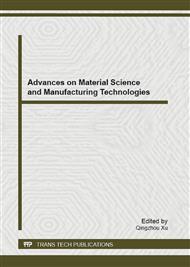[1]
Kawakami M, Terada O, Hayashi K (2006) J Jpn Soc Powder Powder Metall 53:166
Google Scholar
[2]
Lay S, Hamar-Thibault S, Lackner A. Location of VC in VC, Cr3C2 codoped WC–Co cermets by HREM and EELS. Int J Refract Met Hard Mat 2002;20:61–9.
DOI: 10.1016/s0263-4368(01)00071-3
Google Scholar
[3]
A. Bock, W.D. Schubert, B. Lux, Powder Metall. Int. 24, 20 (1992).
Google Scholar
[4]
Pastor H., Titanium-carbonitride-based hard alloys for cutting tools, Mater. Sci. Eng. A, 1988, 105-106: 401.
DOI: 10.1016/0025-5416(88)90724-0
Google Scholar
[5]
Tjong S.C. and Chen H., Nanocrystalline materials and coatings, Mater. Sci. Eng R, 2004, 45: 1.
Google Scholar
[6]
Sun L., Jia C.C., Lin C.G.., and Cao R.J., VC addition prepared ultrafine WC-11Co composites by spark plasma sintering, J. Iron Steel, 2007, 14: 85.
DOI: 10.1016/s1006-706x(08)60057-6
Google Scholar
[7]
Morton C.W., Wills D.J., and Stjernberg K., The temperature ranges for maximum effectiveness of grain growth inhibitors in WC-Co alloys, Int. J. Refract. Met. Hard Mater., 2007, 23: 287.
DOI: 10.1016/j.ijrmhm.2005.05.011
Google Scholar
[8]
Spriggs GE. A history of fine grained hardmetal. Int J Refract Met Hard Mat 1995;13:241–55.
Google Scholar
[9]
Kawakami M, Teranda O, Hayashi K. Segregation amount of dopants at WC/Co interface in Cr3C2- and VC+Cr3C2-doped WC–Co submicro-grained hardmetals. In: Kneringer G, Rodhammer P,Wildner H, editors. Proceedings of the 16th International Plansee Seminar, vol. 2. Reutte: Plansee Holding AG; 2005. p.653–67.
DOI: 10.2497/jjspm.53.166
Google Scholar
[10]
Carroll D.F., Sintering and microstructural development in WC/Co-based alloys made with superfine WC powder, Int. J. Refract. Met. Hard Mater., 1999, 17: 123.
DOI: 10.1016/s0263-4368(98)00073-0
Google Scholar
[11]
Gille G, Szesny B, Dreyer K, van den Berg H, Schmidt J,Gestrich T, Leitner G (2002) Int J Ref Met Hard Mater 20:3
DOI: 10.1016/s0263-4368(01)00066-x
Google Scholar
[12]
Brieseck M, Bohn M, Lengauer W (2010) J Alloys Compounds 489:408
Google Scholar
[13]
Da Silva A.G.P., De Souza C.P., Gomes U.U., Medeiros F.F.P., Ciaravino C., and Roubin M., A low temperature synthesized NbC as grain growth inhibitor for WC-Co composites, Mater. Sci. Eng. A, 2000, 30: 242.
DOI: 10.1016/s0921-5093(00)00993-x
Google Scholar


